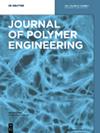An experimental investigation on the influence of pore foaming agent particle size on cell morphology, hydrophobicity, and acoustic performance of open cell poly (vinylidene fluoride) polymeric foams
IF 1.7
4区 工程技术
Q4 POLYMER SCIENCE
引用次数: 0
Abstract
Globally, the development of porous structured materials has been receiving incredible responses for various high-performance engineering applications. Piezoelectric cellular foams have recently attracted the attention of researchers to emerging applications of acoustic sensors, low-frequency hydrophones, and energy-harvesting devices. As pore morphology is closely related to the shape and the size of the pore-foaming agent, it is necessary to address the influence of particle size of the foaming agent on cell morphology to expand their application area. Hence, this research article establishes the impact of particle size of pore foaming agents on pore morphology, hydrophobicity, and acoustic characteristics of open-cell polyvinylidene fluoride (PVDF) based piezoelectric cellular composites. Open-cell PVDF cellular composites have been fabricated using the template removal method with sodium chloride (NaCl) as a sacrificial templating agent in three different particle sizes: larger, medium, and finer. Based on the experimental results, it can be stated that the particle size of the templating agents dramatically influences the pore morphology, hydrophobicity, and acoustics performance of the PVDF foam samples. The PVDF foams possessing medium pore size have exhibited a maximum sound absorption coefficient of 0.89 at a frequency range of 1,000–1,500 Hz, indicating that PVDF foams have great potential for noise-controlling applications.孔隙发泡剂颗粒大小对开孔聚偏氟乙烯聚合物泡沫的细胞形态、疏水性和声学性能影响的实验研究
在全球范围内,多孔结构材料的开发在各种高性能工程应用中得到了令人难以置信的响应。最近,压电蜂窝泡沫在声学传感器、低频水听器和能量收集装置等新兴应用领域引起了研究人员的关注。由于孔隙形态与孔隙发泡剂的形状和大小密切相关,因此有必要解决发泡剂粒径对细胞形态的影响问题,以拓展其应用领域。因此,本文研究了孔发泡剂的粒度对基于开孔聚偏二氟乙烯(PVDF)的压电蜂窝复合材料的孔形态、疏水性和声学特性的影响。以氯化钠(NaCl)为牺牲模板剂,采用大、中、细三种不同粒度的模板去除法制造了开孔聚偏二氟乙烯(PVDF)蜂窝复合材料。实验结果表明,模板剂的粒度对 PVDF 泡沫样品的孔隙形态、疏水性和声学性能有显著影响。具有中等孔径的 PVDF 泡沫在 1,000-1,500 Hz 频率范围内的最大吸声系数为 0.89,这表明 PVDF 泡沫在噪声控制方面具有巨大的应用潜力。
本文章由计算机程序翻译,如有差异,请以英文原文为准。
求助全文
约1分钟内获得全文
求助全文
来源期刊

Journal of Polymer Engineering
工程技术-高分子科学
CiteScore
3.20
自引率
5.00%
发文量
95
审稿时长
2.5 months
期刊介绍:
Journal of Polymer Engineering publishes reviews, original basic and applied research contributions as well as recent technological developments in polymer engineering. Polymer engineering is a strongly interdisciplinary field and papers published by the journal may span areas such as polymer physics, polymer processing and engineering of polymer-based materials and their applications. The editors and the publisher are committed to high quality standards and rapid handling of the peer review and publication processes.
 求助内容:
求助内容: 应助结果提醒方式:
应助结果提醒方式:


